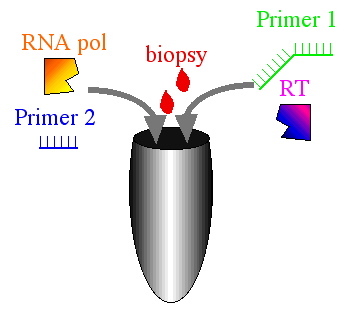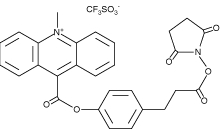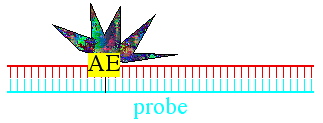Transcription Mediated Amplification (TMA)
(isothermal reaction in one tube)
This method was developed by Dr. Larry Mimms, an alumnus of Davidson College. His invention is used to test most of the blood processed in the US as well as a large percentage of donated blood around the world. For his efforts, Mimms's employer Gen-Probe was awarded the National Medal of Technology in 2004.
To start, take a blood sample (or biopsy another tissue), and put into a single tube along with reverse transcriptase (RT), RNA polymerase, and two primers that bind to the target DNA or RNA template (HIV in this case). In addition, the reaction mixture needs a buffer, dNTPs and NTPs for the production of DNA and RNA, respectively.

Step 1. Mix all ingredients
The biopsy cells are lysed, and the amplification begins when primer 1 binds to the target template (HIV's RNA genome). RT synthesizes a complementary DNA strand and degrades the HIV genome template.

Step 2. Primer #1 binds, and
RT binds to 3' end of primer.
Note that primer #1 has a small extension that does not bind to HIV.


Step 3. RT synthesizes first strand of cDNA (left) and degrades RNA template (right). These two steps are not separated in reality but are done so here for illustration purposes only.
Once the first cDNA strand is synthesized, a second primer binds, and RT produces double stranded cDNA that also includes the small extension from primer #1. This extension is a promoter recognized by the RNA polymerase included in the TMA reaction.

Step 4. Primer #2 binds to the cDNA, and RT begins synthesis for the second strand of cDNA.

Step 5. RT synthesizes the second strand of cDNA including the promoter extension of primer #1.
Now the RNA polymerase is able to bind to the dsDNA promoter sequence and begin transcription. Transcription happens many times to amplify the original one HIV template by 100 to 1000 fold.

Step 6. RNA polymerase binds to the promoter sequence of the dsDNA.

Step 7. RNA polymerase produces a new copy of the original template (HIV genome).

Step 8. Transcription happens 100 - 1000 times to amplify the original template.
In the end, each of the newly synthesized RNA templates serve as starting material for step 2 above, and the entire process is repeated over and over again.
Note that unlike PCR, the reaction remains at a constant temperature! Within 15 - 30 minutes over 10 billion copies of the HIV RNA are produced in a single tube.
TMA Detection
PC Once the RNA is amplified, it needs to be detected. To do this, the amplicons are incubated with a probe of DNA that is covalently modified with acridinium ester (AE). Any probe that is not hybridized with the RNA will lose its AE when exposed to hydroxide ions (high pH).


Step 9. The reaction is stopped and mixed with a ssDNA probe (left) that contains acridinium ester (AE; right side) marker.


Step 10. Some probe will hybridize to the amplified RNA and protect the AE from destruction. Unprotected AE is cleaved from the probe and degraded.
If the probe hybridized with an RNA amplicon, then the AE is protected and will produce light in the presence of a superoxide. This light can be measured and is proportional to the number of template molecules (HIV genomes) in the initial reaction.

Step 11. When mixed with the appropriate substrate, the AE is modified and emits light as a product of the chemical reaction.
Go to the Biology Dept. Main Page
© Copyright 2008 Department of Biology,
Davidson College, Davidson, NC 28036
Send comments, questions, and suggestions to: macampbell@davidson.edu